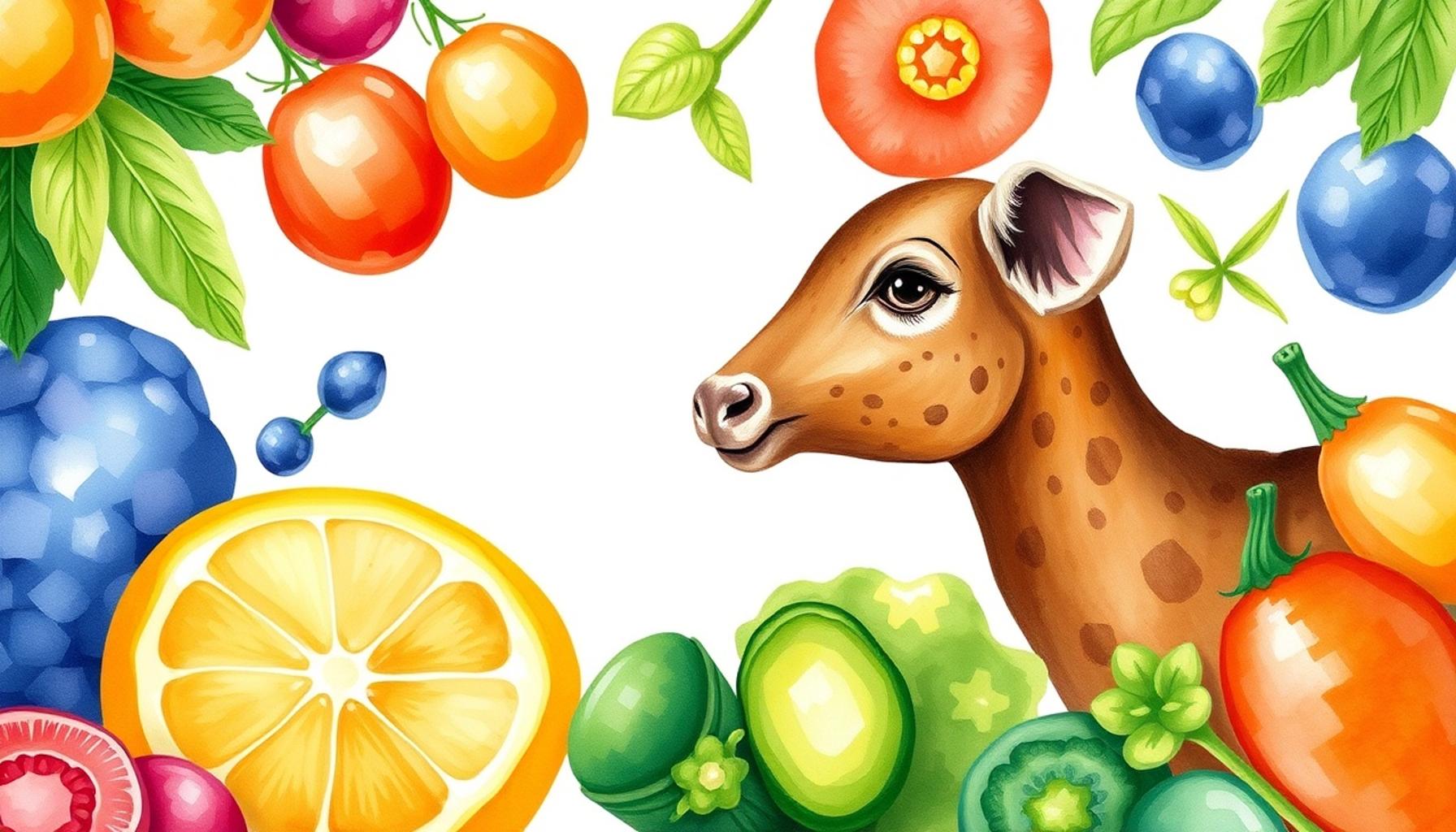How to Identify Food Allergies in Pets and Adjust the Diet

Understanding Food Allergies in Pets
Pets, like humans, can suffer from food allergies, which may lead to various health issues. These allergies can manifest in subtle and overt ways, making it essential for pet owners to be aware of potential symptoms. By recognizing these signs, you can ensure your furry friends receive the care they need. The implications of food allergies can be particularly concerning in Nigeria, where varying pet food options and ingredients greatly influence pet health.
Common Signs of Food Allergies
- Itchy skin or rashes
- Gastrointestinal issues such as vomiting or diarrhea
- Ear infections or inflammation
- Chronic paw licking or chewing
Identifying the root cause of these symptoms is crucial for proper treatment. For instance, if your dog constantly scratches at their skin, it could indicate a reaction to a specific ingredient in their food, such as corn or chicken. In Nigeria, conditions such as heat and humidity can exacerbate these symptoms, making pet owners vigilant in monitoring their pets. Even subtle changes in behavior or bodily function should not be overlooked, as they could indicate an allergic reaction that needs addressing.
Adjusting Their Diet
Once you’ve identified possible food allergies, adjusting your pet’s diet is the next necessary step. Consider the following approaches for effective dietary management:
- Introduce a hypoallergenic diet or single protein sources that your pet hasn’t previously consumed. For example, if your dog is allergic to chicken, you might try a diet based on fish or venison.
- Stay away from common allergens like soybean, wheat, and dairy, which are prevalent in many commercially available pet foods in Nigeria. Understanding ingredient labels is essential.
- Monitor and document any dietary changes and their effects. Keeping a food journal can help you pinpoint which foods may cause a reaction, making it easier to customize your pet’s diet.
By being proactive in managing your pet’s diet, you can significantly improve their overall well-being. It’s not just about eliminating discomfort; understanding how to address food allergies is vital for their long-term health. Moreover, a careful dietary approach can strengthen the bond between you and your pet, fostering mutual trust and happiness. If you suspect your pet has an allergy, consulting with a veterinarian experienced in pet nutrition is advisable, as they can guide you through the process based on your pet’s specific needs.
LEARN MORE: This related article may interest you
Recognizing the Symptoms of Food Allergies
Identifying food allergies in pets is often a challenging endeavor for many pet owners in Nigeria. While the symptoms can be widespread, they frequently manifest in a variety of ways that may not be immediately linked to their diet. Pet owners must be vigilant and observe any unusual behaviors or physical symptoms that might indicate food allergies. These reactions can stem from reactions to specific ingredients or additives commonly found in commercial pet foods.
Physical Symptoms to Watch For
When diagnosing food allergies, there are several key physical symptoms you should monitor. Here are the most notable signs:
- Itchy Skin and Inflammation: This is one of the most common indicators. If your pet is incessantly scratching or biting at their skin, it is a good idea to assess their diet, as this behavior may point to an allergic reaction.
- Gastrointestinal Distress: Recurrent vomiting, diarrhea, or flatulence can be indicative of food allergies. If your pet experiences these symptoms consistently after meals, it may suggest a sensitivity to a specific food component.
- Frequent Ear Infections: Persistently inflamed or infected ears are another potential sign. Yeast infections commonly accompany allergies due to increased moisture in the ears as a result of skin irritation.
- Behavioral Changes: Increased irritability, lack of energy, or reluctance to engage in previously enjoyed activities can also reflect discomfort linked to food allergies.
In Nigeria’s climate, with its heat and humidity, these symptoms can become exacerbated. For instance, a pet’s skin irritation might worsen due to environmental factors in combination with an allergic reaction. Therefore, being observant and reactive to any symptom changes is crucial for maintaining your pet’s health and happiness. Compile a list of changes you notice in your pet’s behavior and physical condition, and this may assist your veterinarian in establishing a potential diagnosis.
Tracing the Allergens
After you’ve identified these symptoms, the next step is tracing the allergens. This requires a systematic approach. A common method includes an elimination diet, where you can remove potential allergens from your pet’s meals to see if the symptoms subside. The following strategies can help streamline this process:
- Focus on Novel Proteins: Select ingredients that your pet has never eaten before, like duck or rabbit. This minimizes the likelihood of an allergic reaction occurring.
- Eliminate Grains: Many pets are sensitive to grains, especially wheat and corn, which are prevalent in many commercial feeds. Opting for grain-free formulas can be a beneficial step.
- Consult Your Vet: Engaging a veterinarian for appropriate guidance is highly recommended. They can provide insights and even suggest specific brands or homemade diets tailored for your pet’s unique needs.
Taking careful steps to identify food allergies in pets is crucial not just for their immediate comfort but also for their long-term health. An understanding of potential allergens paired with a conscious effort to adjust their diet can lead to a happier, healthier pet. With the right approach and expert guidance, overcoming food allergies is an achievable goal that significantly improves their quality of life.
Understanding Food Allergies in Pets
Identifying food allergies in pets can be a complex process that requires careful observation and evaluation. Pets, like humans, can have various adverse reactions to their diet that may not always manifest as immediate symptoms. One of the most common signs of food allergies is skin irritation, which may include itching, rashes, or hot spots. In addition to skin-related reactions, gastrointestinal issues such as vomiting, diarrhea, or excessive gas can also indicate a food intolerance.It is essential to keep a diary of your pet’s symptoms and dietary intake to pinpoint the potential allergens. When a reaction occurs, note the food consumed prior to the symptoms. This practice not only helps in recognizing patterns but also assists your veterinarian in making informed decisions regarding possible allergens.In severe cases, pets may experience more pronounced symptoms such as facial swelling, difficulty breathing, or anaphylactic reactions, which require immediate veterinary attention. Different pets may react to different allergens, but common culprits include ingredients such as beef, dairy, wheat, soy, and chicken.
Adjusting Your Pet’s Diet
Once you have identified potential food allergens, the next step involves adjusting your pet’s diet. After consulting your veterinarian, consider implementing an elimination diet. This involves feeding your pet a simplified diet containing only one source of protein and carbohydrate that your pet has never consumed before. This approach helps in determining which specific food items may be causing allergies.The elimination period usually lasts around 8 to 12 weeks, during which it is crucial not to introduce any new foods or treats that could interfere with the results. Following the elimination phase, gradual reintroduction of one food item at a time allows you to isolate and identify which ingredients cause adverse reactions.Feeding your pet a hypoallergenic diet—often available through veterinary clinics—can also be an option. These diets are scientifically formulated to reduce allergy symptoms while providing balanced nutrition. Regular follow-ups with your veterinarian during this time are vital to track your pet’s response and make necessary adjustments to their diet as needed. Remember, the key to managing food allergies is patience and vigilance, as it may take time to find the right dietary balance for your furry friend.
| Category 1 | Category 2 |
|---|---|
| Common Allergens | Beef, Dairy, Wheat, Soy, Chicken |
| Symptoms | Skin irritation, Vomiting, Diarrhea, Gas |
Adapting a pet’s diet accordingly not only improves their overall health but also enhances their quality of life. Understanding food allergies in pets is essential for any pet owner, leading to better dietary choices and reduced health risks. Stay observant and proactive in your pet’s care; a happy, healthy fur baby is the ultimate reward!
RECOMMENDED: Check out this similar article
Adjusting Your Pet’s Diet after Identifying Allergies
Once you have successfully recognized the symptoms and traced potential allergens in your pet’s diet, the next step involves making the necessary dietary adjustments. The process of modifying your pet’s food can be as crucial as identifying the allergies themselves. In Nigeria, where access to a variety of pet foods may be limited, pet owners must remain adaptable and creative in finding solutions.
Implementing an Elimination Diet
The elimination diet serves as a fundamental strategy in dietary adjustments. By temporarily removing all potential allergens and then reintroducing them one by one, you can help pinpoint specific unwanted reactions. Here’s how to implement this effectively:
- Select a Limited Ingredient Diet: Choose a commercial diet that contains only a couple of ingredients, focusing on protein sources like rabbit or venison, paired with a single carbohydrate.
- Duration is Key: Keep the elimination diet intact for at least 6 to 12 weeks. This time allows the immune system to settle and enables you to observe any improvements in your pet’s condition.
- Attention to Detail: Monitor their behavior closely during this period. Any resurgence of symptoms upon reintroducing a suspected allergen can confirm its role in your pet’s allergic response.
Transitioning to New Foods
When introducing new foods, it’s important to do so gradually to avoid added stress to your pet’s digestive system. Here are some practical tips to make this transition smoother:
- Gradual Introduction: Mix the new food with the old over several days, slowly increasing the proportion of the new food. This method not only helps in digestion but also allows you to monitor reactions more effectively.
- Monitor Response: Keep a strict log of any changes in behavior, bowel movements, and physical symptoms during the transition. If symptoms reappear, consider eliminating the newly introduced food.
- Homemade Diets: In instances where commercial foods do not suit your budget or dietary requirements for your pet, consider preparing homemade meals. Incorporating fresh vegetables, meats, and grains can provide a balance tailored to specific needs. Just ensure that meals are well-balanced and fortified with necessary vitamins and minerals.
Ongoing Dietary Management
Managing food allergies in pets is not a one-time fix. It demands ongoing attention and adaptation to ensure your pet remains healthy and comfortable. Here are some strategies to maintain effective dietary management:
- Regular Vet Consultations: Keeping communication lines open with your veterinarian can lead to regular evaluations of your pet’s diet and health. They can assist in tailoring a long-term plan that accommodates any changes in your pet’s health.
- Read Labels Carefully: Always scrutinize ingredient labels on pre-packaged foods. Ingredients can vary significantly between brands, and cross-contamination during manufacturing can also pose risks.
- Consider Supplementation: Discuss with your vet the possibility of adding supplements to your pet’s diet, such as Omega fatty acids for skin health or probiotics for gut health, depending on their specific needs.
With persistent attention and dedication, adjustments to your pet’s diet can significantly enhance their quality of life. Adapting diet plans according to specific allergies fosters better health, ultimately allowing pets to lead more active and happier lives in Nigeria’s vibrant environment.
YOU MAY ALSO LIKE: Read read another article
Conclusion: Navigating Food Allergies in Pets
Identifying and managing food allergies in pets is a nuanced journey that requires dedication, observation, and knowledge. As a pet owner, but especially in the diverse pet-loving communities of Nigeria, it’s imperative to understand how allergies manifest and impact your furry friends. Recognizing symptoms early—like itching, digestive disturbances, or unusual behavior—can lead to timely interventions, ensuring that your pet’s well-being is prioritized.
The transition to a suitable diet is not merely an adjustment; it’s a commitment to improving your pet’s quality of life. The elimination diet serves as a powerful tool in helping to identify specific allergens. However, it’s essential to approach this process with patience, duplicating the gradual introduction of new foods while continuously monitoring your pet’s response. With a growing local market for pet foods, from imported brands to homemade meals, innovative solutions should be readily available.
Ultimately, consulting with a veterinarian is vital to create a structured dietary plan that aligns with your pet’s unique health needs. Regular check-ups, continuous learning, and vigilance about ingredient labels can further safeguard your pet’s health. By implementing these strategic approaches, pet owners can foster an environment where their beloved companions thrive, ultimately leading to happier and healthier lives.
Embrace the journey of dietary management, and remember—every small step taken not only heals your pet but also strengthens the bond between you and your four-legged family member.



